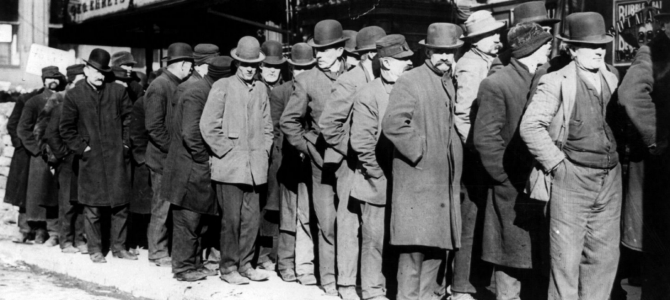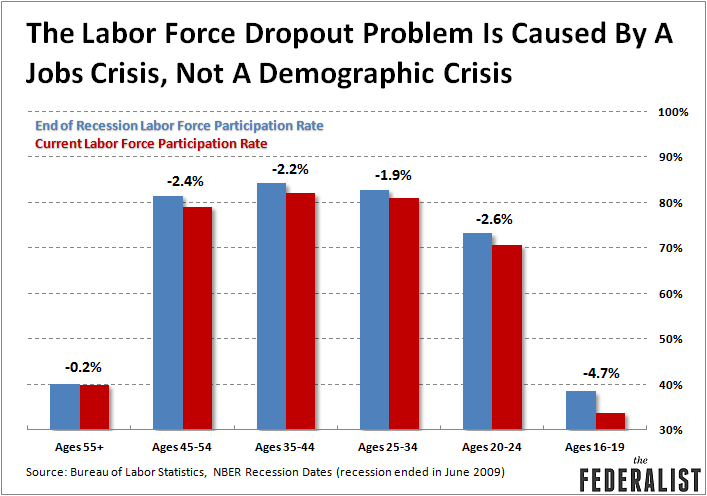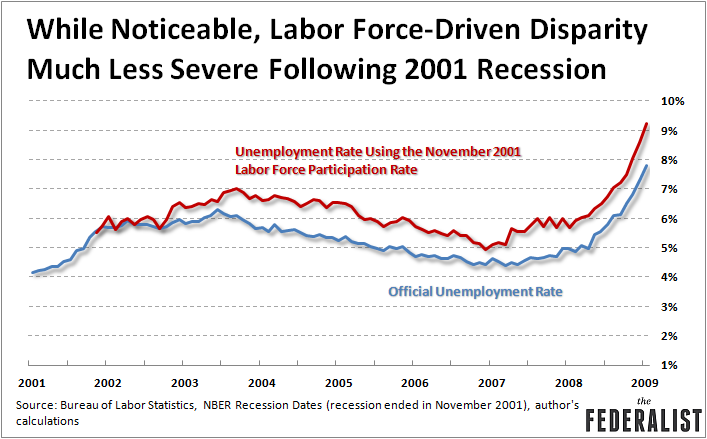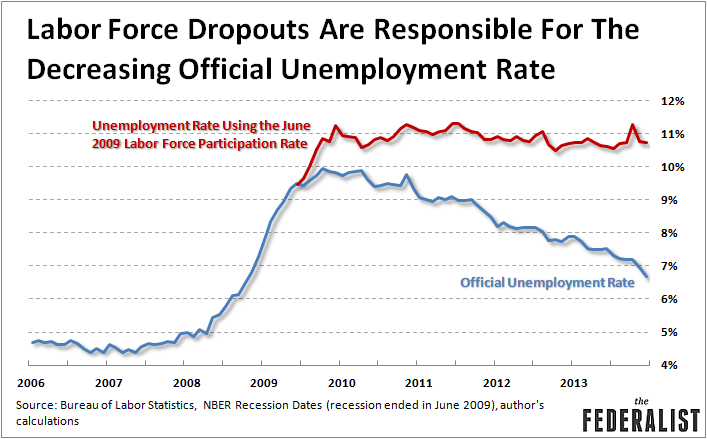
Last Friday, I compiled and posted a chart showing how labor force dropouts are largely responsible for the declining unemployment rate. Some commentators, however, believe the steep drop in the labor force participation rate to be primarily a function of demographic change: baby boomers are getting older, retiring, and leaving the labor force. In a speech following the release of December’s employment data last Friday, St. Louis Federal Reserve Bank President Bullard endorsed this view, saying the labor force drop appears “driven by demographics rather than being cyclical in nature.”
The data tell a different story. In fact, most evidence suggests that while demographics aren’t completely irrelevant, the American economy is currently facing a jobs crisis, not a demographic one.
In order to analyze to what extent demographics and an aging American population are responsible for the recent and sizable increase in the number of labor force dropouts, we must first posit what the data would look like under that scenario. The most obvious sign would be a big drop in the labor force participation rate of those aging baby boomers. Is that what we see in the data?
Nope. We actually see the exact opposite.
Since the end of the recession in June of 2009, the labor force participation rate for those who are 55 years of age and older has actually remained remarkably steady, according to Bureau of Labor Statistics (BLS) data. At the end of June of 2009, 40.1 percent of those within that age cohort were included in the labor force. At the end of last month, that number was 39.9 percent. Since the end of recession, it has averaged 40.3 percent. In contrast, the labor force participation rate for the economy as a whole has fallen by nearly 3 percentage points. Since the end of the recession, the employment-population for the 55+ crowd even ticked up a bit, from 37.4 percent in June of 2009 to 37.9 percent today.
So much for the argument that baby boomer demographics are the true cause of the labor force dropout crisis. The source of the labor force dropout problem must therefore lie among those younger than the 55+ crowd:

Since the end of the recession, the labor force participation rate declines have only affected those cohorts younger than 55 years old. As shown in the above chart, the rate for the 45-54 cohort is down 2.4 percent. For the 35-44 cohort, it’s down 2.2 percent. For the 25-34 cohort, it’s down 1.9 percent. For the 20-24 cohort, it’s down 2.6 percent. And for those between the ages of 16 and 19 years, the labor force participation rate has dropped 4.7 percent (since January of 2001, it has fallen 17.9 percent, likely due in no small part to the federal minimum wage increase of $2.10, 0r 41 percent above the rate of $5.15/hour in 2001). This BLS table, which compares 2012 data to 2002 data, tells roughly the same story.
Unsurprisingly, the sharp drops for each age group began right around the end of 2007, when the recession began. That certainly strikes me as a cyclical problem caused by the economic downturn. But what do the experts — for example, those who work at the same Federal Reserve as James Bullard — have to say about the issue?
Using state-level evidence on the relationship between changes in employment and labor force participation across recessions and recoveries, we find evidence, reinforcing other research, that the recent decline in participation likely has a substantial cyclical component.
That comes from this May 2013 study, entitled “Will Labor Force Participation Bounce Back?,” by economists Leila Bengali, Mary Daly, and Rob Valletta. The authors analyzed state-level employment data during and after the recession to determine whether there was a significant cyclical labor force effect (a demographic effect, since it would be independent of the underlying economy, would generally be referred to as a structural effect). They found that during the economic downturn, participation rates were positively correlated with payroll employment. When employment fell, so did labor force participation rates, and vice versa.
Unfortunately, that hasn’t been the case during the recovery, according to the authors. Participation rates have not yet bounced back:
However, the current weak correlation between changes in employment and labor force participation could reflect employment’s relatively modest recovery to date. The economy has been expanding for a sustained period. But, as of March 2013, we have recovered only 67% of total jobs lost during the downturn. Thirty-seven months after the employment trough in past recoveries, employment greatly exceeded the pre-recession peak.
As of today, the U.S. economy is still 2 million jobs short of its pre-recession peak, which was reached in November of 2007.
One of the authors’ statistical findings for the most recent recession — that the employment/participation rates are generally linked and cyclical — was not the case, though, for the 2001 recession. The following chart, which shows what the post-2001 recession unemployment rate would be if the November 2001 (end of recession) labor force participation rate was held constant, bears that out:


As the 2001 chart shows, labor force changes had something of an effect on the official unemployment rate, but nothing compared to the effect we’ve seen from the most recent recession and recovery. In 2001, the gap between the “modified” and the official unemployment rates quickly stabilized. Today, the gap is big and getting bigger.
Now, you could try to make the argument that this all does prove that it’s a demographic problem: those baby boomers are deciding to stay in the workforce instead of retiring, and that’s reducing the number of jobs available to the 45-54-year-olds below them, who then end up stealing jobs from the 35-44-year-olds below them, and so on and so forth.
That’s not really a demographics problem, though. If older people feel compelled to keep working because they can no longer afford to retire, that’s not a demographic problem; it’s a jobs- and income-induced economic problem — one that suggests our economy is not producing the kind of jobs and incomes that working families need and expect. Sometimes the simplest answer is also the most accurate one: America has a jobs crisis.
If the labor force dropout data are any indication, a depressingly large number of American workers lack any hope that it will change any time soon.









